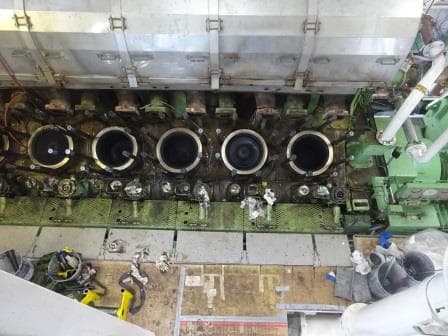Today we have a sea day as the distance Willemstad to Cartagena is too long to cover in one night. And while the departure from Willemstad can be done quite quickly, arrival in Cartagena takes at least one hour as the ship has to sail through the whole inland bay. Spreading it out over a day at sea gives the need for only 12 knots and thus the good ship Zuiderdam is moving along quite sedately.
This area, above the Venezuelan and Colombian coast is the windiest area of the Caribbean if the Trade Wind is blowing at full force. As explained before the Trade wind is mainly generated by a permanent imbalance between a high pressure system over the Atlantic Ocean and a low pressure system in the neighborhood of Panama. This high pressure is mainly generated by the sun during the day and becomes less during the night. Hence you see quite often the wind dying down in St. Thomas and Puerto Rico a few hours after sun set. The more sea area covered by the sun, the more “push” the wind will get; and the Trade Wind in this area has had the additional boost from sunny weather in the Caribbean Sea. So while wind force 4 is normal in Barbados, wind force 5 is normal in Aruba and wind force 6 not unusual here above Colombia. Looking out of my window I can see indeed a wind force 6 blowing over the wave tops. But as we are going to the West and the wind is coming from the East, the Trade Wind is a following wind and thus helps us with the speed.
Going against the Trade wind can easily slow the ship down by ½ to ¾ of a knot. So it should be the same the other way as well. When going against the wind, the wind is quite easily deflected around the hull by the curved bow, and the flat but curved superstructure. At the back we have balconies and wind likes balconies. All those little open sided shoe boxes where the wind can bite into and cannot be deflected from. So along as the wind is blowing faster than the ship is travelling through the water it will push against the ship, give the ship some extra momentum and help us save some fuel. And that makes the Chief Engineer happy.
He needs some happiness, as we have engine nbr 2 under major maintenance /overhaul. That happens after every so many 1000’s hours of operation and then the whole engine is taking apart until only the frame work is left standing. This is done to see if everything is in good order but it also means that something could be found so the C/E worries until he has made his big inspection and sees that all is well. As the ship has five engines, it is normal for one engine to be off line as the other four are more than powerful enough to provide the speed needed for the cruise. We seldom need more than 3 engines so we even have a engine spare if something would happen to the other three.

This is how a 12 cylinder V engine looks like when the complete top has been striped away. You can see the 6 holes where the pistons are normally located. The other six holes for the pistons (although we call them cylinders) are on the other side. The dismantling of the engine is well on its way.
Unfortunately for the ship’s crew and the shore side specialists working on the engine, the overhaul period falls exactly in the warmest time of the cruise ship calendar. If it can be done, Alaska or Europe is used as a much better option as the Engine Room is then much cooler as the outside sea water is so much colder. So I always have the greatest respect for engineers as I would be totally incapable of working down there, day after day, in a hot and humid environment, with greasy engines. I am currently going through the engine room to review all the operational procedures there and the fact that I cannot look outside is already enough to have me look longingly to each escape door that I pass.
Tomorrow we will have an early day. We are supposed to be docked well before 07.00 and that means picking up the pilot at the Boca Chica pilot station in the dark and then spend an hour sailing through the inner bay. Quite scenic as the oil refineries and the High Rises of downtown are normally lit up like a Christmas tree but maybe too early for most of our guests. We will only stay there until 13.00 hrs. otherwise we will not make the Panama Canal on time. Most of the morning will be spent by the crew on drills, and to make everybody’s life hot and horrible, I have scheduled a fire drill in the Oil Purifier Room which is the hottest part of the engine room (but also the most dangerous one) Outside the temperature might reach the 90oF / 33oC if the wind dies down early in the day.

Leave a Reply